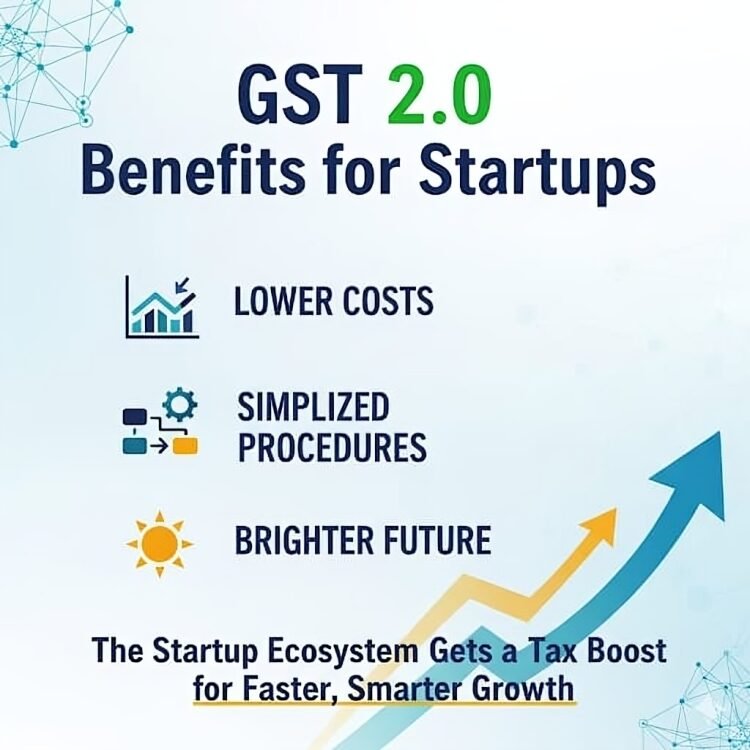India’s startup landscape is set for a significant transformation with the rollout of GST 2.0, the country’s most ambitious indirect tax overhaul since 2017. As the reformed two-slab GST structure takes effect from September 22, 2025, entrepreneurs and their ventures stand to gain from lower costs, simplified compliance, and a more predictable tax environment.
Lower Costs, Greater Flexibility
One of the biggest pain points for startups has been the multiple GST slabs, leading to higher costs for essential services, raw materials, and office equipment. GST 2.0 consolidates the previous four slabs into two key rates; 5% and 18% – with a special 40% rate only for luxury or sin goods. Essential goods and services now fall under the 5% slab, reducing the working capital burden on young businesses. Common procurement items like IT hardware, office supplies, and everyday business inputs are now more affordable, helping startups channel limited resources towards product development and growth.

Simplified Procedures & Faster Refunds
Startup founders often cite GST compliance as a time-consuming hurdle. GST 2.0 addresses this with streamlined processes:
- Automated registrations quicken the process of getting a new business off the ground.
- Faster, tech-enabled refunds improve liquidity for cash-strapped startups, eliminating long refund cycles.
- Simplified return filing procedures free up founders’ time and reduce dependence on costly professional help.
Reduced Compliance Burden
With the reduction of tax slabs and clear categorization of goods and services, startups now face fewer ambiguities and surprises during audits or while claiming input tax credits. The new system’s standardized procedures and technology-driven administration mean fewer disputes, less paperwork, and easier access to GST advisory.
Expanding Opportunities
GST 2.0’s push for wider exemptions, particularly for essential services and health insurance, brings direct savings for startups offering employee benefits or operating in healthcare and allied sectors. Additionally, the improved ease of doing business is likely to attract more investors and ecosystem partners, spurring a new wave of entrepreneurial activity.
A Brighter Future for Indian Startups
As India cements its position as one of the world’s most vibrant startup hubs, GST 2.0 promises to clear regulatory roadblocks and give founders more freedom to innovate. By making indirect taxation fairer, cheaper, and simpler, the reform paves the way for a startup ecosystem that is faster, smarter, and primed for the future. With these changes, entrepreneurs can now focus on what matters most: solving real problems, building scalable businesses, and driving India’s economic growth.
Industry Voices: GST 2.0 Reform Applauded Across India Inc.
India Inc. is rallying behind the GST 2.0 reform, with business leaders across sectors applauding its far-reaching benefits for manufacturers, retailers, and consumers alike. The shift to a simplified two-slab structure, coupled with rationalized rates and streamlined administration, is being hailed as a catalyst for cost reduction, innovation, and digital acceleration. Industry experts believe these changes will energize local manufacturing, enhance compliance ease, and unlock new momentum across the value chain.
Ankur Mittal, Co-Founder, Inflection Point Ventures (IPV): “GST 2.0 is a great initiative from the government that not only simplifies the tax framework but will also create a powerful base for India’s economic growth. With the removal of complex taxes and cutting on working capital blockages, it gives a consumption boost across businesses generating strong domestic demand which accounts for nearly 60% of India’s GDP. Rationalisation of gst slabs is likely to widen the tax base thus generating more revenue for the govt and at the same time bringing more businesses under a formal economy. Such reforms further improve ease of doing business. We believe GST 2.0 will deliver benefits across sectors and further strengthen its economy”.
Shweta Rajpal Kohli, President and CEO, Startup Policy Forum:
“Startup Policy Forum welcomes the landmark GST rate reform, moving from four slabs to a simpler two-rate structure. This ‘Simple Tax’ regime will provide a much-needed clarity and predictability for businesses – cutting red tape and easing compliance for startups and MSMEs.
We particularly commend the decision to keep EVs at the concessional 5% slab, a clear boost for India’s clean mobility vision and a strong signal of policy certainty for innovators and investors across the mobility and green technology spectrum. Equally encouraging are the rate cuts on auto parts, small cars, renewable energy devices, medical supplies, and life-saving drugs – reforms that go beyond balance sheets to directly impact sectors like healthcare, manufacturing, transport, sustainability, and social impact.
SPF strongly believes this reform not only lightens the tax burden but also puts ‘fuel in the tank’ for startups driving innovation, jobs, and India’s journey towards Viksit Bharat @ 2047.”
Rajeev Singh, Managing Director, BenQ India:
“The recent GST reform is a decisive move toward simplifying and streamlining the tax structure for the electronics industry. By consolidating the tax slabs into a clear and predictable two-tier system, it reduces compliance complexities and fosters a more transparent business environment. This reform is set to benefit manufacturers, retailers, and consumers by lowering costs across the supply chain, encouraging competitive pricing, and stimulating demand for a wide range of electronic goods. Moreover, it supports the government’s vision to enhance local manufacturing and innovation, providing a strong foundation for sustainable growth in the sector. Notably, the reduction of GST rates on products such as monitors and projectors further eases costs for businesses and educational institutions, promoting wider adoption of digital technology solutions across India.”
Ravi Agarwal, Co-Founder and Managing Director, Cellecor:
“We welcome the recent GST reforms as a decisive step towards creating a more level playing field and fostering growth within the consumer electronics and appliances industry. The rationalization of GST rates to a uniform 18% on products such as TVs, monitors, air conditioners, and dishwashers is a particularly positive move. It not only enhances affordability for Indian households but also simplifies compliance and operational efficiency for manufacturers and brands like Cellecor.
Equally significant is the alignment of GST on lithium-ion batteries at 18%. This will have a direct impact on the ecosystem of wireless, portable, and smart devices by reducing input costs across the value chain. For a fast-growing Indian brand like Cellecor, this encourages us to accelerate innovation in smart gadgets and energy-efficient products while keeping them accessible to a wider base of consumers.
Overall, these reforms are a timely enabler for greater consumer confidence and demand creation. They strengthen the foundation for digital adoption across urban and rural markets alike, supporting our long-term vision of bringing quality, affordable technology to every Indian family.”
Aditya Khemka, Managing Director, CP PLUS:
“The recent GST revisions are a progressive step for India’s technology ecosystem. Rationalizing taxes on consumer electronics, critical components like silicon wafers, and logistics will help reduce the cost of hardware that powers modern surveillance infrastructure, making advanced security solutions more accessible to businesses, housing societies, and urban centers. While adjustments may be needed on account of higher GST on outsourced job work, the overall direction supports affordability, faster adoption, and strengthens the government’s vision of Atmanirbhar Bharat by boosting local manufacturing and value creation. For the surveillance industry, this creates an important opportunity to accelerate organized deployment and deliver safer, smarter communities across the country.”
Pankaj Rana, Chief Executive Officer, Hisense India:
“The government’s recent GST reforms on televisions and air conditioners come at a critical juncture. By reducing price barriers, these reforms enable a larger and more diverse consumer base, especially in emerging markets and Tier-2 and Tier-3 cities, to access high-quality, energy-efficient products. At Hisense India, our focus has always been to deliver global innovation at prices that resonate with Indian households, and this move makes our advanced range of TVs and home appliances even more accessible ahead of the festive season, when families are looking to upgrade their homes. Ultimately, this reform not only improves affordability but also elevates the quality of life for millions of Indian households.”
Ravi Kunwar, VP and CEO, HMD India & APAC:
“The latest GST reforms mark a constructive development for diverse industries across India, with the Council’s move to consolidate rates and streamline registration and refund processes driving substantial change in business operations nationwide. By simplifying the tax structure into clear 5% and 18% slabs, these reforms are set to promote consumer savings and create more disposable income, delivering timely relief and positive sentiment ahead of the festive season.
These measures reflect India’s continued pursuit of regulatory ease, and their true value will be seen in how effectively benefits extend to both consumers and industry progress—particularly in manufacturing and technology. For HMD and the broader telecom sector, we expect improved operational efficiency, greater cost predictability, and sustainable growth, reinforcing our commitment to supporting India’s digital transformation and the vision of Viksit Bharat@2047. Going forward, clarity in implementation will be key to enabling all stakeholders to fully leverage these reforms.”
Vedant Goel, CEO, Enlight Metals:
“The latest GST reform has opened up new opportunities for both consumers and industries, with a direct impact on the steel sector. Automobiles, which earlier attracted a tax rate of nearly 28% or were charged according to cubic capacity, will now fall under the 18% bracket. This sharp reduction is expected to immediately revive demand for cars, tractors, and even bicycles. Since steel forms the backbone of the automobile industry, the reform translates into a significant boost for steel consumption.
Beyond automobiles, GST rates on essential products like shampoos, soaps, hair oils, and face powders have also been rationalized. With lower taxes, more manufacturing units are likely to be set up in these segments, which were previously neglected due to higher tax structures. This renewed industrial activity will further drive demand for steel in construction, machinery, and allied industries.
For the steel sector, the move brings a two-fold benefit: direct growth from the automobile industry and indirect gains from rising consumer goods manufacturing. Coming just ahead of the festive season, the reform is being viewed as a strong positive for the economy. It is expected to accelerate industrialization and provide timely support to both industries and consumers.”
Rajeev Gupta, Joint Managing Director, RSWM Ltd:
“We welcome the Government’s forward-looking GST reform, which will have a far-reaching impact on India’s economic growth by improving affordability, reducing working capital requirements, and boosting demand across industries. For the textile sector, this is a particularly transformative step. The reduction of GST on manmade fibre from 18% to 5% and on synthetic yarn from 12% to 5% will significantly strengthen the domestic textile industry, enhance competitiveness, and stimulate consumption. The revision of the apparel slab, raising the limit from ₹1,000 to ₹2,500, will provide a powerful boost to garments and apparel demand, thereby creating new opportunities across the textile value chain. At the same time, we believe that harmonizing GST on recycled polyester fiber and its raw material, PET bottles (18%), is an important area that needs attention to unlock the full potential of circular textiles. We remain committed to driving sustainable innovation, scaling domestic production, and contributing to India’s journey towards Viksit Bharat @2047”.
Akash Agrawalla, Co-founder, ZOFF Foods:
“The new GST reforms mark a pivotal moment for India’s FMCG and food processing industries. By rationalising tax slabs and reducing rates, the government is boosting demand, easing compliance, and supporting homegrown brands. At ZOFF Foods, we see this as a timely, progressive move that allows us to scale faster, innovate more, and offer even better value to our consumers, especially with the festive season ahead. It will also help us accelerate market expansion across Tier 2 and Tier 3 cities, unlocking new growth corridors for the sector at large.”
Agnishwar Jayaprakash, Founder and CEO, Garuda Aerospace:
“We welcome this landmark move and believe that the reduction of GST to 5% will empower drone-tech companies in multiple ways. For companies like Garuda Aerospace, which strongly believe that indigenous drones are the need of the hour, this reform provides the opportunity to deepen investments in R&D, foster innovation, and scale up manufacturing. Lower costs also enable us to explore entry into new markets, encouraging and promoting the wider use of drones. This move directly improves the affordability of drones for farmers and allied sectors, further boosting the adoption of agri-drones across the country. It is also a step forward for initiatives like NaMo Drone Didi, which promote precision agriculture through drone usage. Moreover, it equips defence and surveillance sectors with cost-effective drone solutions for public safety, disaster management, and other critical applications. We anticipate that this progressive step towards making India the global hub for drone technology and being Atmanirbhar Bharat will enhance productivity and efficiency, while accelerating drone adoption across industries such as logistics and infrastructure.”





